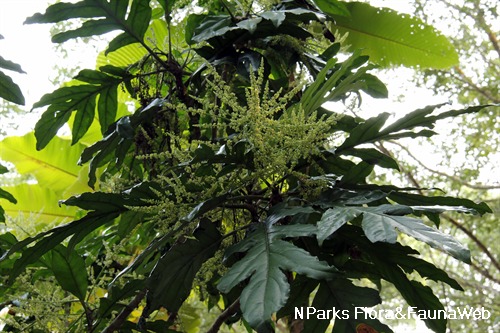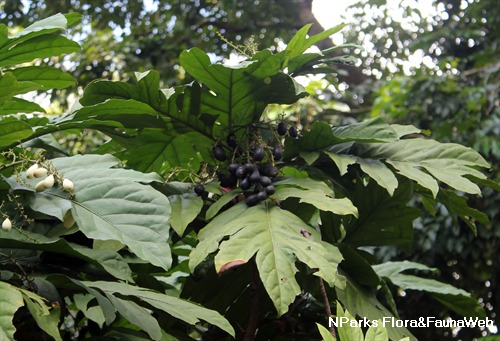
Back
Aralidium pinnatifidum (Jungh. & de Vriese) Miq.
| Family Name: | Torricelliaceae |
| Common Name: | False Ivy-Palm, Balai, Sebalai, Balai Balai, Puah Pungah |
Name
Classifications and Characteristics
| Plant Growth Form | Tree |
|---|
Biogeography
| Native Distribution | Peninsular Thailand, Borneo, Malaysia, Sumatra (Indonesia) |
|---|---|
| Native Habitat | Terrestrial |
| Preferred Climate Zone | Tropical, Highland / Montane |
| Local Conservation Status | Native to Singapore (Critically Endangered (CR)) |
Description and Ethnobotany
| Growth Form | Small forest understorey tree to 10m tall |
|---|---|
| Foliage | Leaves simple, usually deeply pinnately lobed but occasionally entire in some specimens. Leaf blades with 4-10 lobes or sometimes with 12 lobes, to 25-80cm long by 17-52 cm wide; lobes sub-opposite. |
| Flowers | Male and female flowers borne on separate inflorescences; male inflorescences to 40cm in length, often longer than female inflorescences. Flowers numerous, small, to 0.25cm, cream - pale yellow; male flowers with petals to 0.15cm in length, petals in female flowers often falling off shortly after the flowers are opened. |
| Fruit | Fruits ellipsoidal (slightly assymetric), to 4.5cm long, white turning purplish black when ripe, . |
| Habitat | Lowland - montane forests up to 1,250m; apparently a widespread species throughout its range, but is nowhere common. |
| Etymology | The specific epithet 'Pinnatfidum' refers to the pinnately lobed leaves |
| Ethnobotanical Uses | Medicinal: Traditional Medicinal Uses In Southeast Asia countries like Malaysia, the plant is used in traditional medicine to treat conditions, such as fever <1> and kidney diseases <2>. It is important to note that some therapeutic effects from traditional medicinal uses of plants are not currently supported or verified by scientific research. It is advised to seek medical advice before the use of relevant plant materials. Timber & Products: This species produces a fine grained, dull/ light red hardwood that has been used to make parquet flooring, tables as well as upright supports of bridges in times past. |
Landscaping Features
| Desirable Plant Features | Ornamental Foliage, Ornamental Form |
|---|---|
| Landscape Uses | Parks & Gardens, Small Gardens, Focal Plant |
| Thematic Landscaping | Bird & Wildlife Garden |
Fauna, Pollination and Dispersal
| Pollination Method(s) | Biotic (Fauna) |
|---|---|
| Seed or Spore Dispersal | Biotic (Fauna) |
Plant Care and Propagation
| Light Preference | Semi-Shade, Full Shade, [Remarks] (Will tolerate full sun, but does best in semi shaded conditions) |
|---|---|
| Water Preference | Moderate Water, Occasional Misting |
| Plant Growth Rate | Moderate |
| Rootzone Tolerance | Moist Soils, Well-Drained Soils, Fertile Loamy Soils |
Foliar
| Foliage Retention | Evergreen |
|---|---|
| Mature Foliage Colour(s) | Green |
| Foliar Margin | Pinnately Lobed / Pinnatifid |
| Leaf Area Index (LAI) for Green Plot Ratio | 3.0 (Tree - Intermediate Canopy) |
Floral (Angiosperm)
| Flower Colour(s) | Cream / Off-White, Yellow / Golden |
|---|---|
| Flower Grouping | Cluster / Inflorescence |
Fruit, Seed and Spore
| Mature Fruit Colour(s) | Black, Cream / Off-White, Purple |
|---|
References
| References | <1> Noor, R., Khozirah, S., Mohd Ridzuan, M.A.R., Ong, B.K., Rohaya, C., Rosilawati, M., Hamdino, I., Badrul A. & Zakiah, I. (2007). Antiplasmodial properties of some Malaysian medicinal plants. Tropical Biomedicine 24(1): 29-35. <2>Silalahi, M., Nisyawati & Pandiangan, D. (2019). Medicinal plants used by the Batak Toba Tribe in Peadundung Village, North Sumatra, Indonesia. Biodiversitas 20 (2): 510-525. |
|---|
Image Repository
Others
| Master ID | 1426 |
|---|---|
| Species ID | 2719 |
| Flora Disclaimer | The information in this website has been compiled from reliable sources, such as reference works on medicinal plants. It is not a substitute for medical advice or treatment and NParks does not purport to provide any medical advice. Readers should always consult his/her physician before using or consuming a plant for medicinal purposes. |





.jpg)
.jpg)